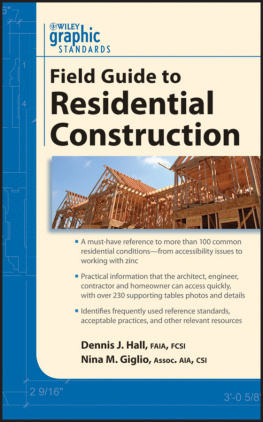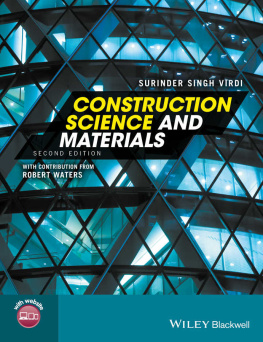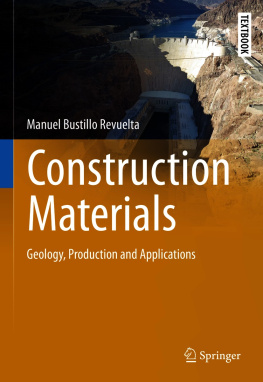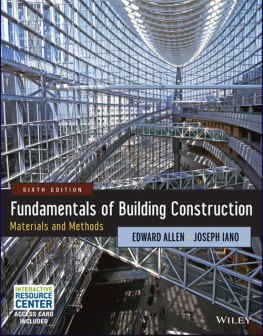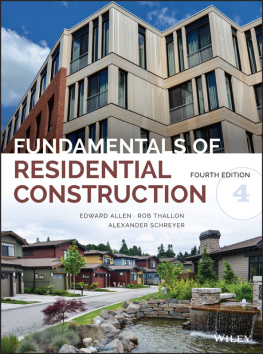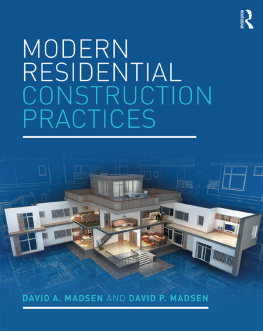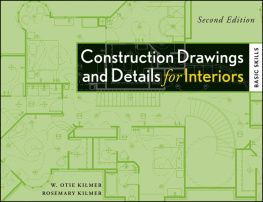Construction Databook
About the Author
Sidney M. Levy is an independent construction industry consultant with more than 40 years of experience in the profession. He is the author of numerous books on construction methods and operations, including Design-Build Project Delivery, Construction Superintendents Operations Manual, and Project Management in Construction for which he was awarded the British Chartered Institute of Building Silver Medal in the category of Managing Construction.
Construction Databook
Construction Materials and Equipment
Sidney M. Levy
Second Edition


Copyright 2010, 1999 by The McGraw-Hill Companies, Inc. All rights reserved. Except as permitted under the United States Copyright Act of 1976, no part of this publication may be reproduced or distributed in any form or by any means, or stored in a database or retrieval system, without the prior written permission of the publisher.
ISBN: 978-0-07-161358-3
MHID: 0-07-161358-7
The material in this eBook also appears in the print version of this title: ISBN: 978-0-07-161357-6, MHID: 0-07-161357-9.
All trademarks are trademarks of their respective owners. Rather than put a trademark symbol after every occurrence of a trademarked name, we use names in an editorial fashion only, and to the benefit of the trademark owner, with no intention of infringement of the trademark. Where such designations appear in this book, they have been printed with initial caps.
McGraw-Hill eBooks are available at special quantity discounts to use as premiums and sales promotions, or for use in corporate training programs. To contact a representative, please e-mail us at bulksales@mcgraw-hill.com.
Information contained in this work has been obtained by The McGraw-Hill Companies, Inc. (McGraw-Hill) from sources believed to be reliable. However, neither McGraw-Hill nor its authors guarantee the accuracy or completeness of any information published herein, and neither McGraw-Hill nor its authors shall be responsible for any errors, omissions, or damages arising out of use of this information. This work is published with the understanding that McGraw-Hill and its authors are supplying information but are not attempting to render engineering or other professional services. If such services are required, the assistance of an appropriate professional should be sought.
TERMS OF USE
This is a copyrighted work and The McGraw-Hill Companies, Inc. (McGraw-Hill) and its licensors reserve all rights in and to the work. Use of this work is subject to these terms. Except as permitted under the Copyright Act of 1976 and the right to store and retrieve one copy of the work, you may not decompile, disassemble, reverse engineer, reproduce, modify, create derivative works based upon, transmit, distribute, disseminate, sell, publish or sublicense the work or any part of it without McGraw-Hills prior consent. You may use the work for your own noncommercial and personal use; any other use of the work is strictly prohibited. Your right to use the work may be terminated if you fail to comply with these terms.
THE WORK IS PROVIDED AS IS. McGRAW-HILL AND ITS LICENSORS MAKE NO GUARANTEES OR WARRANTIES AS TO THE ACCURACY, ADEQUACY OR COMPLETENESS OF OR RESULTS TO BE OBTAINED FROM USING THE WORK, INCLUDING ANY INFORMATION THAT CAN BE ACCESSED THROUGH THE WORK VIA HYPERLINK OR OTHERWISE, AND EXPRESSLY DISCLAIM ANY WARRANTY, EXPRESS OR IMPLIED, INCLUDING BUT NOT LIMITED TO IMPLIED WARRANTIES OF MERCHANTABILITY OR FITNESS FOR A PARTICULAR PURPOSE. McGraw-Hill and its licensors do not warrant or guarantee that the functions contained in the work will meet your requirements or that its operation will be uninterrupted or error free. Neither McGraw-Hill nor its licensors shall be liable to you or anyone else for any inaccuracy, error or omission, regardless of cause, in the work or for any damages resulting there from. McGraw-Hill has no responsibility for the content of any information accessed through the work. Under no circumstances shall McGraw-Hill and/or its licensors be liable for any indirect, incidental, special, punitive, consequential or similar damages that result from the use of or inability to use the work, even if any of them has been advised of the possibility of such damages. This limitation of liability shall apply to any claim or cause whatsoever whether such claim or cause arises in contract, tort or otherwise.
Contents
Introduction
The Construction DataBook, Second Edition, provides the project manager, construction superintendent, design consultants, facility managers and owners with a one-source guide for the most commonly encountered construction materials and equipment.
Composed of eleven sections ranging, in topics, from excavation and sitework to mechanical and electrical components, the book also includes a handy set of useful tables and formulas. Quick and easy access to informative data on these materials and systems is afforded.
Much of this material has been gleaned from manufacturers and suppliers data but a great deal of these specifications and installation procedures are generic in nature.
The Construction DataBook, Second Edition includes several HVAC, plumbing and electrical and alternative energy schematics that explain complex systems in easy-to-understand terms. Installation instructions for subjects as diverse as piles to plastic pipe joining techniques are included in the book. This one-source volume can prove invaluable for office- and field-based design and construction personnel since it contains many of the materials and equipment incorporated in todays building projects.
How many times during project meetings, field visits, or conversations with architects, engineers, general contractors, and subcontractors has it been helpful to have ready access to a concise source of information about product data under discussion? The Construction DataBook, Second Edition fulfills that need.
I have selected the construction components, material specifications, and typical installation procedures, that, in my forty years experience in the construction industry appear to be those for which reference material is so often required, and, as usual, required yesterday.
I hope you find the Construction DataBook, Second Edition a worthwhile addition to your construction library.
Sidney M. Levy
Section 1
Soils, Site Utilities, Sitework Equipment
Contents
1.0.0 Soil Types and Classification
The general classification of soils is divided into the following broad categories:
Gravel
Sand
Silt
Clay
Organic
1.0.1 A Glossary to Better Understand Soil Terminology
AASHTO American Association of State Highway and Transportation Officials.
AASHTO T-180 American Association of State Highway and Transportation Officials standard for the modified Proctor test.
AASHTO T-99 American Association of State Highway and Transportation Officials standard for the standard Proctor test.
Aeolian deposits Wind-deposited materials such as sand dunes or other silty-type materials.
Next page

